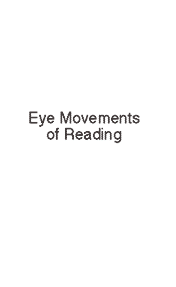James O. Phillips, Ph.D.
Something
Navigation:
Welcome

The Clinical Oculomotor Laboratory provides research and clinical testing of eye movements and visual physiology. We study how the eye moves and how that affects vision in healthy children, and we apply that knowledge to help children with a variety of medical conditions.
A collaboration between the Division of Ophthalmology, Department of Surgical Services, Children's Hospital and Regional Medical Center and the Department of Otolaryngology-HNS University of Washington.
Located in the Ophthalmology (Vision) Clinic at:
Children's Hospital and Regional Medical Center
Seattle Campus
4800 Sand Point Way, NE
Seattle, Wa, 98105

Welcome
Eye movements are a very important part of your vision. You are often walking, running, jumping and turning when you look at the things around you, and you can only see those things if your eyes move too.
Activity: You can prove this to yourself if you hold your thumb at arm's length and look at it. You can see your thumb very clearly. Now shake your head while you look at your thumb. You can still see your thumb clearly because your eyes are moving in your head. Now shake your thumb while your head is still. Now your thumb is blurred because it is moving and your eyes can't keep up. In order to see something clearly, your eyes must stay aimed at that thing. When you move, your eyes move the other way to keep aimed at whatever you need to see.

What is amazing about these eye movements is that they occur even in the dark. If you turn your head in the dark, your eyes move to keep looking straight ahead, even through you can't see a thing. That is because a part of your ear actually tells your brain to move your eyes. Weird!. We study these eye movements by having kids sit in a chair that we can turn slowly indifferent directions. Above is a picture of our chair taken with a camera that can see in the dark. If you want to see it turn, click on the picture. You may have to wait a long time for it to spin.
Without eye movements, you would not be able to see a face or read a book. When we look at a face, our eyes move in quick jumps to look at each part of the face. In the picture below, we have slowed down the eye movements of someone looking at a face. The green dot shows where the eye is looking and the red lines show where the eye has moved. This is the way that you and I look at a face too.

We also move our eyes when we read. In the picture below, we have slowed down the eye movements of someone reading a poem so that you can see how their eyes jump from word to word and line to line. Without quick jumping eye movements, we would not be able to read well.
Participation
The Clinical Oculomotor Laboratory at Children's Hospital participates in a variety of community outreach and education activities, and professional education activities, in coordination with the University of Washington Departments of Otolaryngology - Head and Neck Surgery and Ophthalmology, and Children's Hospital and Regional Medical Center. Select the links below to view some recent and planned activities in these affiliated centers.
Children's Hospital and Regional Medical Center
Department of Otolaryngology - Head and Neck Surgery, University of Washington
Virginia Merrill Bloedel Hearing Research Center, University of Washington